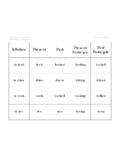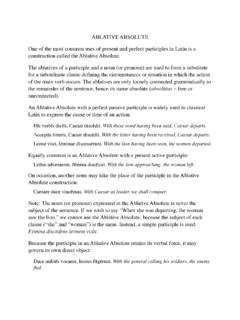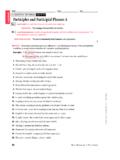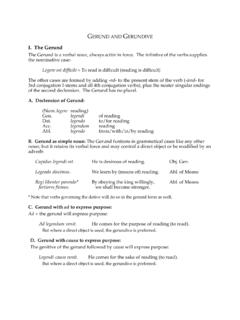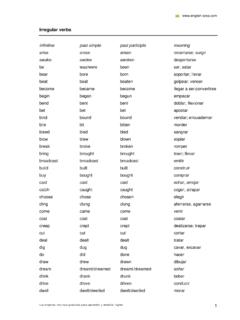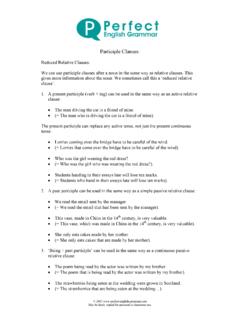Transcription of Past Tense - David's Homepage
1 1 past TenseHow is the past Tense formed in Czech?How can it be translated into English?What complications of past - Tense usage need to be noted?The past Tense in Czech is formed by combining an auxiliary verb which indicates theperson and number of the verb s subject with a past form of the main verb. The pastform of the main verb is called the past participle or the l-participle, and it agrees ingender and number with the subject of the are some examples of the past Tense that have been analyzed for auxiliary verb(bolded) and l-participle (bolded and underlined):Tam jsme celou noc danced all night jste n kdy v esk republice?Have you ever been in the Czech Republic?Kdy jsem byla mal , bydlela jsem v Austr I was little, I used to live in m , co jsi cht l?
2 Do you already have what you wanted?Mo e vypadalo jako sea looked like a vyhr li zlato!The hockey players won gold!Ne ekan zem el zp v k Petr singer Petr Muk has unexpectedly t kali a ko ky m dogs were barking and the cats were that the Czech past Tense can be translated variously into English. Thus thepast- Tense form Bydlel/Bydlela could be rendered depending on the contextthat it occurs in as I was , I , I have , or I used to also that the auxiliary verb in third-person singular and plural (the last fourexamples above) is a null verb. In other words, there is no auxiliary verb for thesecases; the l-participle alone suffices to render the past note the various forms of the l-participle as it takes endings appropriate to thenumber and gender of the subject: -l (masculine singular); -la (feminine singular orneuter plural); -lo (neuter singular); -li (masculine animate plural); -ly (feminine pluraland masculine inanimate plural).
3 2 Given their need to be in grammatical agreement, l-participles for the pronoun vy covera whole range of possibilities depending on the number and gender of the vy subject:Byl jste n kdy v Praze?The addressee is one jste n kdy v Praze?The addressee is one jste n kdy v Praze?The addressee is plural and contains at least one jste n kdy v Praze?The addressee is plural and all see how these factors play out in ll the past - Tense forms of a given verb, here is thepast paradigm of b t followed by some examples of its usage: Singular Plural (j )byl / byla jsem(my)byli / byly jsme (ty) byl / byla jsi(vy)byli / byly jste [sg formal: byl / byla jste] (on)byl(oni)byli (ona) byla(ony)byly (ono)bylo(ona)bylaByla jsem cel v kend v pr [fem] was at work all ichni t i byli docela norm ln three were completely normal t jsme v Americe [fem pl] haven t been to America byly unaven.
4 The girls were bylo window was k m jsi byl nejv c spokojen?Who were you [masc sg] most satisfied with?Kde jste byli minul t den?Where were you [masc pl] last week?Kdo u byl n kdy v Evrop ?Who has ever been to Europe?3 The Czech past Tense combines with verbal aspect to indicate an activity or process inthe past (via the imperfective aspect) or a completed event (perfective aspect). Notethe contrasts in meaning:Dlouho jsem psala esej, ale je t jsem ho was writing the essay for a long time, but I haven t finished writing it yet. ps t = imperfective napsat = perfectiveKapit n hodn pil. Podle m ho vypil nejm n litr tvrd ho captain was drinking a lot. In my estimation he drank up at least a liter of hard alcohol.
5 P t = imperfective vyp t = perfectiveTo negate a past - Tense utterance, simply add ne- to the l-participle:Man el u nebydleli husband and wife weren t living together any v ivot v bec nic neva hasn t cooked anything at all in his whole v jsem na ve ejnosti nezp haven t sung in public doma one was at jsi dom c kol neud lala?You haven t done your homework?Formation of the l-participleThe l-participle of a verb is regularly formed by dropping the -t of the infinitive andadding -l in its place. Thus:vid t:vid l, vid :tancoval, lat:d lal, d :mluvil, monosyllabic infinitives with long vowels, the vowels almost always shorten in thel-participle (the shifts of - - to - - and -ou- to -u- are, historically speaking, instances ofshortening):b t:byl, t:m l, m t:cht l, cht t:pil, t:dal, t:psal, :minul, monosyllabic verbs in - t retain the long vowel in the past ; common examplesinclude hr t (hr l, hr la), st t (st l, st la), b t se (b l se, b la se), and p t (p l, p la).
6 Many verbs have l-participles that cannot be predicted from the infinitive and mustbe memorized, although sometimes they share something in common with the non-pastconjugation. Some common examples include the following:p ct:pekl, ct: ekl, : eknu, ekne .. st: etl, : tu, te ..j st:jedl, : (oni) jed pomoct:pomohl, :mohl, : (j ) mohuj t: el, order and the past tensePast- Tense auxiliary verbs are generally found in the second position in a sentence orclause. This is evident in all the examples given further complicationsFor reflexive verbs used in the past - Tense ty form, the auxiliary verb jsi combines withthe reflexive se and si to yield ses and sis respectively:Jak bylo? M la ses dob e? Pov dej a nic nevynech!
7 How was it? Did you have a good time? Tell me and don t leave anything out! m t se = m la sesCo sis koupil jako suven r?What did you buy yourself for a souvenir? koupit si = koupil sisMl ky jsi st l a ty ses b l stood quietly and you were afraid to speak. b t se = b l sesIn spoken Czech, the -l of the masculine singular form of some l-participles is oftendropped. These are usually short verbs and always end in a stem-final examples include: ct: ekl > ek5moct:mohl > mohAlso in spoken Czech, the jsi auxiliary can shorten to -s and combine with the initialword of the clause. Examples include: Tys tam nebyla!You weren t there!Je skv l , es v echny ty testy tak zvl s great that you aced all those tam d lal?
8 What were you doing there?



